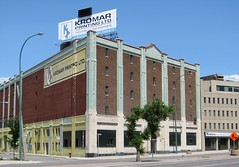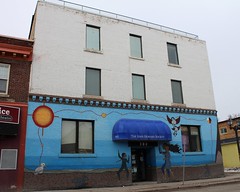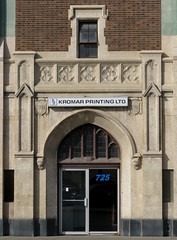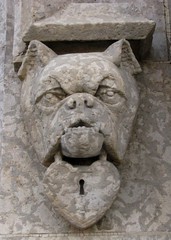Address: 725 Portage Avenue
Opened: July 25, 1929
Cost: $250,000
Architect: J. N. Semmens
Contractor: J. L. Guay
The Security Storage and Warehouse Company was created in February 1909 by Irving M. Winslow. A native of Bloomington, Illinois, he ran the Winslow Furniture and Carpet Company of St. Paul, Minnesota for ten year before coming north. His local investors included Neil MacMillan, William H. Carter, and Jabez B Hugg.
As the name suggests, the company was in the moving and storage business specializing in large loads - everything from pianos and vehicles to entire households and farm equipment.
The company first set up at Vaughan and Graham and immediately drew up plans for their own warehouse, choosing a site at Ellice Avenue and Sherbrook Street.
On January 15, 1910 Security Storage opened 583 Ellice Avenue, which served as its main warehouse and head office. The company retained their space at Vaughan and Graham and the following year took over W. R. Richardson's, a long-time moving and storage company, inheriting their warehouse at 83 Kate Street at McDermot.
Ads ca. 1909 and 1929
In 1914, Security Storage bought a 320 foot lot along McGee Street between Sargent and Wellington on which they built a stables for their 60 horses. Like many company owners who kept large numbers of horses for their business, Winslow showed his best animals around the country and won many awards.
Eventually all but the best horses were pushed aside as the McGee Street location became a garage for their growing fleet of trucks.
In 1925 Winslow was in ill health and gave up the company. He died on November 29, 1925 while visiting his son in St. Paul, Minnesota.
The new owners of Security Storage were the McKeag family with George McKeag as president; Robert McKeag as vice president and W. A. Johnston the secretary treasurer.
Business was good and In the late 1920s plans were made for a new building that would bring all of their operations under one roof.
Above: July 23, 1929, Winnipeg Free Press
In late 1928, architect J. N. Semmens, (Wolseley School, Winnipeg Civic Auditorium, Daniel McIntyre Collegiate), travelled to Chicago to get inspiration for the new building. He found that storage companies were no longer constructing plain, back-street warehouses. Instead, they were emulating banks by choosing prominent locations and erecting imposing structures.
On March 11, 1929 the $250,000 construction contract was let to J. L. Guay, (St. Boniface School of Nursing, Deer Lodge Hospital, Langevin School.) Construction began by the end of the month and the building was completed in just over four months.
Semmens' five storey structure has a reinforced concrete frame with cast concrete walls. The exterior is finished in Twin City Minnesota brick and Tyndall stone. Its most striking feature is the Gothic-inspired doorway. Made of Tyndall stone, it features carved wood panelling and two bulldogs which were hand-carved at a cost of $100 each.
The main floor interior resembled a bank. The main office area located in the centre of the main floor featured Italian marble counters, walnut trim and designer furniture. The main vault was lined with laminated steel, its glass door fitted with a time lock. There were also smaller, air tight, temperature controlled vaults for fur and rug storage.
The rear of the main floor held a garage large enough to hold all of the company's moving vans. The grounds behind had a gas station, mechanics garage and paint room for vehicle repairs. There was also a rug cleaning plant.
The upper floors of the building were dedicated to storage. Some areas featured individual rooms where the goods of a single household could be locked up, other areas were open plan or specialty areas for painos and other delicate goods.
July 25, 1929, Winnipeg Free Press
The building opened on July 25, 1929 at 8:00 pm. According to following day's Free Press, 6,000 people passed through the doors that evening. Guests were treated to refreshments and and the music of an orchestra.
The south-east and south-west corners of the main floor contained retail space. To the east was W. S. Watson's Avenue Motors, a Plymouth dealership, that opened the same night as Security Storage. By 1931 the dealership was gone and it became a Maytag showroom.
In 1940 architect Semmens was called on to design a $25,000 expansion. Three storeys were added to the two storey garage at the rear, (in white, above.) This added 180,000 of storage space to the building binging the total to 1 million square feet. It was said to be the largest storage facility in Western Canada.
December 22, 1954, Winnipeg Free Press
In summer 1954 there was a change in the operations of Security Storage. They got out of the storage business for the most part and focused on being a moving company. By December they were advertising warehouse space for rent.
December 1, 1956, Winnipeg Free Press
George H. McKeag died in 1964. Jack McKeag, a younger member of the family who worked for the company, went on to create McKeag Realty.
In 1972, Security Storage was renamed Hill Security and continued to operate from this address until 1975.
Harold Margolis (source)
In the summer of 1975, the Security Storage building got a new long term owner: Kromar Printing. The company was founded in 1945 or 1946 as Kro-Mar Printing by its two founders Samuel Krolik and Harold Margolis. The company name is the first three letters of their last names.
I can find little on Krolik except that he was a press operator for Baker and Sons printers up until 1945. He lived with has family, wife Rae and son Gerry, on Boyd Avenue. In 1952, they moved to Los Angeles.
Margolis, listed in the Henderson Directories and the proprietor / manager of the company, was born in Chodork, Ukraine and came to Canada with his family when he was 12. He enlisted with the Air Force during World War II and served as an airplane mechanic, reaching the rank of Leading Air Craftsman.
When he returned in 1945 he settled back with his wife Doris, whom he married before leaving, and they began their family which eventually consisted of three daughters.
Above: November 1, 1946, Winnipeg Free Press
Below: October 2, 1947, Winnipeg Free Press
Kro-Mar opened in Lauzon's Block at 229 William Avenue, sharing the retail portion of the building with Acme Upholstery. The first employee of the company was Anne Antaya, bindery worker.
One of the first books printed by the company was a 1946 collection of 30 poems by Winnipegger James P. Brown. He was a paratrooper serving with the First Canadian Parachute Battalion in World War II and wrote the works while overseas. (Perhaps there was a wartime connection between him and Margolis.)
In 1951, the company relocated to 175 King Street, taking over the space once occupied by Reynolds Printing Ltd. In 1962 it was on the move again, likely dislocated due to the construction of new Civic Centre. Kro-Mar spent two years at 114 Market Street and from 1964 - 1974 called 708 Broadway home.
The change in the spelling of the name appears to have happened in 1969 when the company became Kromar Printing (1969) Ltd.
Harold and Doris Margolis were prominent members of Winnipeg's Jewish community. She was best known for her involvement in the arts while Harold was the long-time printer and eventual partner in the Israelite Press newspaper. From 1965 - 68 the Margolis' owned the paper.
Doris died in 1997. Harold died on February 17, 2001.
Kromar Printing still operates from this location with sales offices in Calgary, Ottawa and Toronto. It is one of just a few remaining large-scale printers left in the city as the advent of desktop publishing and other technologies has made many of the jobs of a traditional printer obsolete.
Related:
Photos of 725 Portage Avenue
Security Storage Building 1 Winnipeg Downtown Places
















Thanks for writing this. I've always been curious about this building. You're doing what Heritage Winnipeg should be doing! I just don't know how you have the time do such great research.
ReplyDeleteI think this is the oldest security storage in the history. The facility is well preserved. Still on its feet in competing other big companies.
ReplyDeleteself storage edmonton